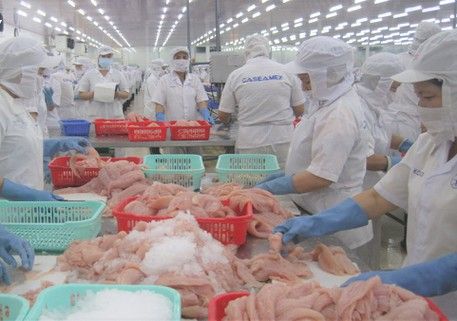 Economy
Economy


|
| Việt Nam's tra fish exports in the European market recorded impressive growth in recent years, up 103 per cent to $190 million.— Photo vov.vn |
HÀ NỘI — Pangasius (tra fish) export growth slowed down from the second quarter of this year to the end of the year, but export turnover is still up on last year.
Việt Nam Association of Seafood Exporters and Producers (VASEP) reported that tra fish export turnover reached US$2.3 billion in the past 11 months, a year-on-year increase of 77 per cent.
The markets that recorded growth were Europe, China and the US.
The European market recorded impressive growth in recent years, up 103 per cent to $190 million. Europe's strong recovery has caused the market share to increase from 7 per cent to 8 per cent of the total export value of Vietnamese tra fish.
Key markets in the EU are the Netherlands, up 72 per cent; Germany, up 182 per cent; and Belgium, up 94 per cent.
The CPTPP market still accounts for 13 per cent of Việt Nam's tra fish export value with more than $310 million, up 74 per cent over the same period last year.
Mexico and Canada are the two biggest importers, with sales of more than $101 million and $55 million, respectively, in the past 11 months, equivalent to respective growth of 67 per cent and 88 per cent year-on-year.
As the second largest Vietnamese tra fish import market, the US accounted for nearly 23 per cent, reaching more than $540 million.
A representative of VASEP commented that the 70 per cent growth of this market was a breakthrough result in the first half of this year when the US economy has not yet fallen into inflation.
However, in the later half of the year, the growth of tra fish exports to the US maintained a slow growth rate because US consumers have had to "tighten their belts" in spending to cope with inflation.
Target of $2.4b this year
Despite slow growth, the tra fish industry is forecasted to reach a record turnover of $2.4 billion this year, Deputy Minister of Agriculture and Rural Development Phùng Đức Tiến said at the press conference last week in the Mekong Delta province of Đồng Tháp.
Tiến said that Vietnamese tra fish is now exported to 138 countries and territories around the world.
About 350 tra fish raising establishments in the Mekong Delta region with a total area of nearly 3,120ha have been certificated to meet Vietnamese Good Agricultural Practices (VietGAP) standards.
This year, the country expects to yield a tra fish output of 1.68 million tonnes.
Tiến said that the fishery sector could rake in a record high of $11 billion from exports this year and that tra fish is among the key products that greatly contributed to the growth.
According to the Vietnam Tra Fish Association, 2022 marks a successful year for the production and trading of tra fish in the Mekong Delta region as domestic tra fish prices are maintained at high level after businesses have made efforts to boost exports.
Last year, the tra fish export value of Việt Nam reached about $1.62 billion, marking an increase of 8.4 per cent compared to 2020.
Tra fish processing and exporting enterprises said that although the world market had many fluctuations, consumers tended to save spending under challenging times, the demand for seafood was still prioritised over many other consumer products.
Lê Hằng, VASEP Pro's communications director, said that the European market still had a lot of room for Vietnamese tra fish.
Although the UK market fell into crisis, this market still imported nearly $300 million of seafood from Việt Nam; tra fish accounted for 20 per cent of this import value, up 3 per cent year-on-year.
For the Chinese market, according to VASEP's assessment, China has always maintained the highest growth, with sales increasing by more than twice over the same period last year. Việt Nam has more than 400 enterprises exporting tra fish to the Chinese market in the first 11 months of this year. — VNS




